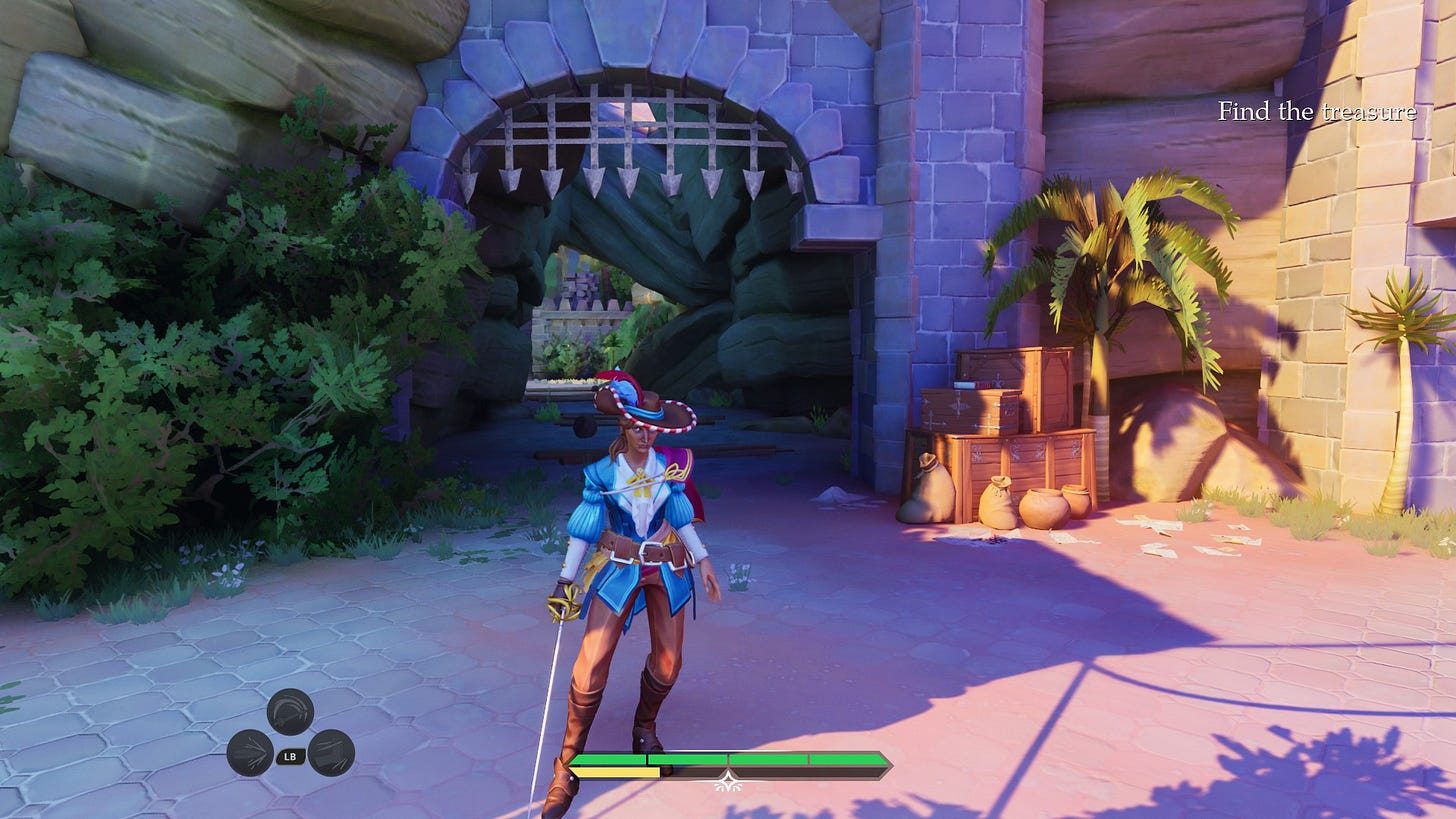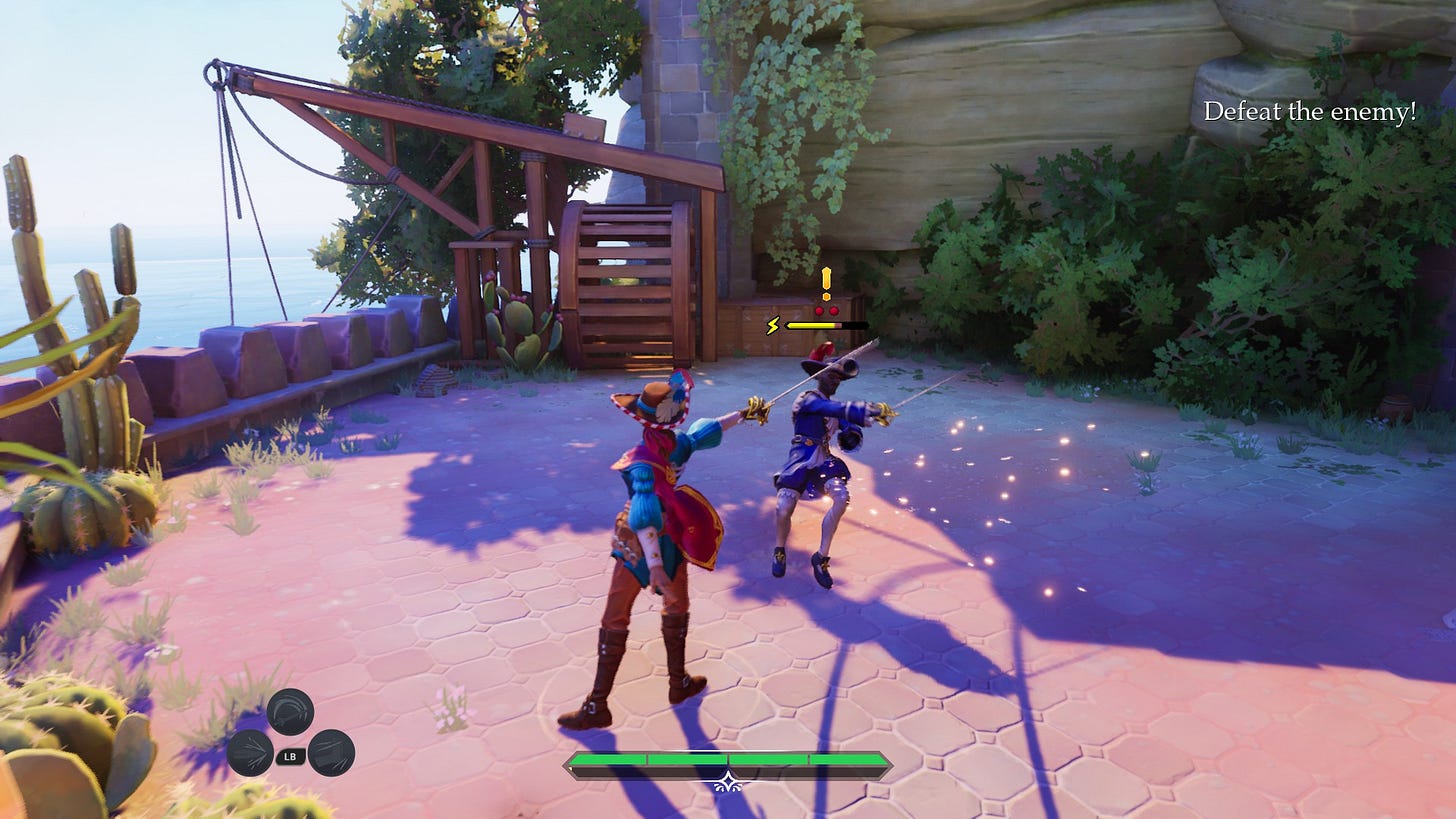I enjoy sword fighting games. The focus on melee combat makes me feel like a swashbuckler and reminds me of my real-life fencing experiences. It can be difficult to get elements like parry and riposte just right, with Sekiro being my go-to for great feeling sword fights. So, when I noticed En Garde! centred fencing I was drawn towards it, and was surprised that it brings the essential aspects I’m looking for into sharp focus.
En Garde! is a fun, light experience. It’s the sort of game where the hero, Adalia Voladore, never kills anyone. You follow her through the brightly coloured, cartoonish adventure as she uses her rapier and fancy hat to undo the schemes of the evil ruler of the city. Characters trade puns as they melodramatically loose sword fights, quip while leaping over tables. I didn’t find it particularly difficult, even on the hardest difficulty, and you could probably speed-run it in less than an hour. I enjoy the bright colours and cartoon aesthetic, and it has a very good soundtrack that fits the game (although it’s not one I’d write a whole essay about). It’s a nice simple framework where the emphasis is on entertainment rather than a deep message about the human condition, which I like. It also makes a change from the brutal and unforgiving games I usually write about.
You’ll be familiar with the general mechanics if you’ve played Sekiro or Sifu - Jacob Geller has given a breakdown of these across his videos. Attacking enemies breaks their guard, at which point you can remove a hit point. Tougher foes have more than one hit-point, and bosses have several. On top of this blue attacks are parried, red attacks are dodged, white attacks can have either. You can surprise or stun foes to create an opening to attack them, helping deal with large groups. Captains carry a buckler which has to be dealt with before you can damage them, and Musketeers and Elite Guards can instantly regain their guard if you make a mistake in the duel. This simple framework emulates fencing in a particularly fun way, which I will now discuss at length.
It’s generally not a great idea to tank an incoming blow. A sharp sword will slice through your soft meats and have a good go at your bones. Even when wearing full knightly harness you want to roll with an incoming strike so it glances off of the plate steel, and Adalia’s only armour is a slashed doublet. Instead you want to parry, deflecting an incoming blow away from you, before attacking into the opening you’ve just made in your opponents defence. Riposting then allows your sword to be a steel ring of protection and a cruel beak pecking whoever comes too close; in En Garde! a perfect parry means a foe takes more posture damage for a brief time. It also lets you kick them down the stairs, which can break their guard and is also very entertaining. This is the limit of complex bladework in the game, but it’s about as complex as the game needs to be to create the feeling of a flashy sword duel.
The foundation of fencing is footwork. It’s important to keep the opponent within fighting distance, such that a sudden explosive lunge can reach past their blade and deliver the winning blow. Footwork also keeps you stable, and your legs provide the raw power compared to the finesse of the arms. In En Garde! this is translated into general movement and mobility, making sure you’re in the right place to avoid being hit and deal effectively with the foes around you. You also have a dodge, which rewards you for not getting hit by giving you a window to counter-attack directly after.
Parries and footwork are only effective if done at the correct moment in a fight. If you attack at the same time as your opponent, you’re left with two fencers bleeding out on the floor. What’s missing from this is the concept of time, the presence of which really makes a game emulate a sword fight. Time is the rhythm of a fight, the dialogue in clashing steel. The first fighter lunges, the second parries, and is then able to riposte. Attacking out of time will punish the player with damage, while respecting time allows you to parry incoming attacks or take advantage of a lull to kick someone. You can feel this while playing – when you don’t have the parry timing down yet you’ll spam the button, versus when you’re a skilled veteran who presses the button once at the right moment.
A key feature of En Garde! is the rewarding of good play, the panache meter. Playing the game well fills the meter which allows you to use special moves, of which there are three. Using panache skills heals Adalia, who is somewhat of a glass cannon who cannot take many hits before going down for good. The extra complication is that most fights are against groups, and they will attack when your back is turned. In this environment, you can’t fight them all honourably. Instead you’re expected to use the environment to your advantage, like Adalia using her mighty boot to kick things - foes down stairs, boxes into enemies. You’re also encouraged to surprise foes with dodges and thrown items, causing them to pause briefly and giving you some breathing room. The general idea is to fight so actively and aggressively that being outnumbered isn’t a big deal.
I really enjoyed playing En Garde!. The game really nails the heroic aesthetic and feeling of being a dueller. I got the most out of it on the hardest difficulty, and playing though it more than once was ideal as it’s at its best once you're used to the mechanics and can swashbuckle at peak efficiency. The best part is that once you’ve got the basic inputs down, it’s hard to look bad playing En Garde!. In no time at all, you’re a verified swashbuckler. The game is short, doing pretty much all it can with its small roster of enemies and environmental hazards, and is never that hard once you get into the swing of it (Adalia’s sword). You can feel that it is struggling for content when the final level includes a boss rush, and I’d like more En Garde! in the future only if something new is added to spice it up. The main takeaway is that right now En Garde! is fun to play.
Further Reading
I Want to Tell You About My Favourite Fight Scene, Jacob Geller, YouTube, 2024.
Sekiro’s Parry and Other Pursuits of Perfection, Jacob Geller, YouTube, 2022.
This work is licensed under CC-BY-SA 4.0







